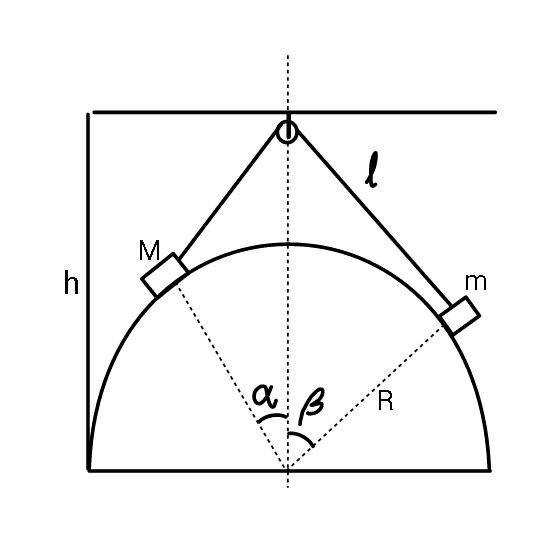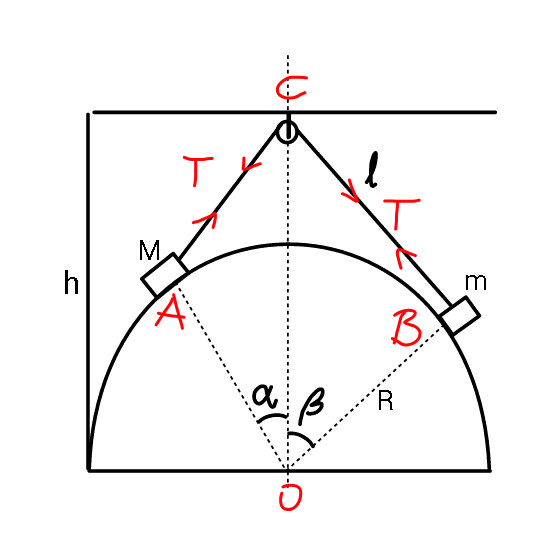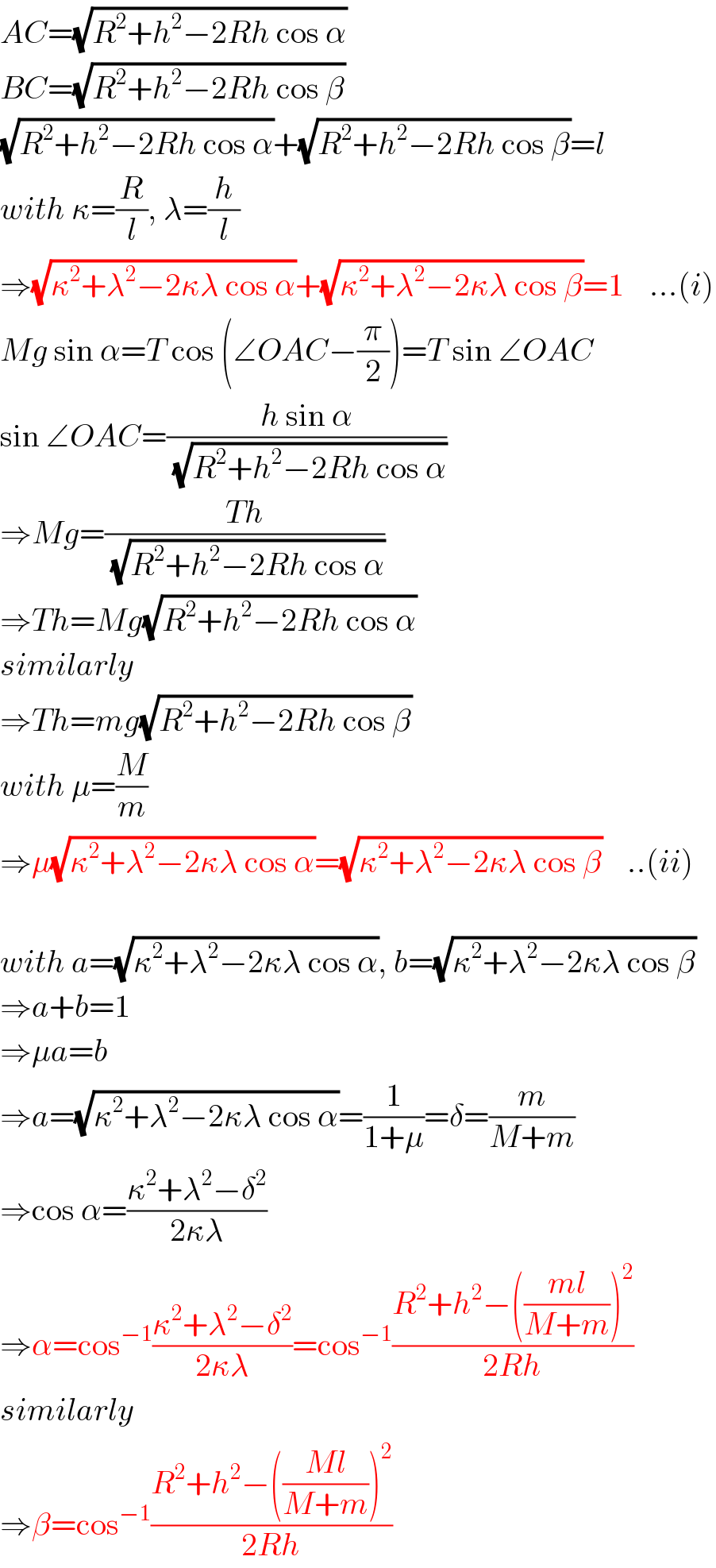Question Number 58257 by ajfour last updated on 20/Apr/19

Commented by ajfour last updated on 20/Apr/19

$$\mathrm{Find}\:{equilibrium}\:{angles}\:\alpha\:\mathrm{and}\:\beta\:\mathrm{if} \\ $$$$\mathrm{the}\:\mathrm{hemisphere}\:\mathrm{is}\:\mathrm{fixed}\:\mathrm{and}\: \\ $$$$\mathrm{frictionless}\:\mathrm{and}\:\mathrm{string}\:\mathrm{has}\:\mathrm{length}\:{l}. \\ $$
Answered by mr W last updated on 20/Apr/19

Commented by mr W last updated on 20/Apr/19

$${AC}=\sqrt{{R}^{\mathrm{2}} +{h}^{\mathrm{2}} −\mathrm{2}{Rh}\:\mathrm{cos}\:\alpha} \\ $$$${BC}=\sqrt{{R}^{\mathrm{2}} +{h}^{\mathrm{2}} −\mathrm{2}{Rh}\:\mathrm{cos}\:\beta} \\ $$$$\sqrt{{R}^{\mathrm{2}} +{h}^{\mathrm{2}} −\mathrm{2}{Rh}\:\mathrm{cos}\:\alpha}+\sqrt{{R}^{\mathrm{2}} +{h}^{\mathrm{2}} −\mathrm{2}{Rh}\:\mathrm{cos}\:\beta}={l} \\ $$$${with}\:\kappa=\frac{{R}}{{l}},\:\lambda=\frac{{h}}{{l}} \\ $$$$\Rightarrow\sqrt{\kappa^{\mathrm{2}} +\lambda^{\mathrm{2}} −\mathrm{2}\kappa\lambda\:\mathrm{cos}\:\alpha}+\sqrt{\kappa^{\mathrm{2}} +\lambda^{\mathrm{2}} −\mathrm{2}\kappa\lambda\:\mathrm{cos}\:\beta}=\mathrm{1}\:\:\:\:…\left({i}\right) \\ $$$${Mg}\:\mathrm{sin}\:\alpha={T}\:\mathrm{cos}\:\left(\angle{OAC}−\frac{\pi}{\mathrm{2}}\right)={T}\:\mathrm{sin}\:\angle{OAC} \\ $$$$\mathrm{sin}\:\angle{OAC}=\frac{{h}\:\mathrm{sin}\:\alpha}{\:\sqrt{{R}^{\mathrm{2}} +{h}^{\mathrm{2}} −\mathrm{2}{Rh}\:\mathrm{cos}\:\alpha}} \\ $$$$\Rightarrow{Mg}=\frac{{Th}}{\:\sqrt{{R}^{\mathrm{2}} +{h}^{\mathrm{2}} −\mathrm{2}{Rh}\:\mathrm{cos}\:\alpha}} \\ $$$$\Rightarrow{Th}={Mg}\sqrt{{R}^{\mathrm{2}} +{h}^{\mathrm{2}} −\mathrm{2}{Rh}\:\mathrm{cos}\:\alpha} \\ $$$${similarly} \\ $$$$\Rightarrow{Th}={mg}\sqrt{{R}^{\mathrm{2}} +{h}^{\mathrm{2}} −\mathrm{2}{Rh}\:\mathrm{cos}\:\beta} \\ $$$${with}\:\mu=\frac{{M}}{{m}} \\ $$$$\Rightarrow\mu\sqrt{\kappa^{\mathrm{2}} +\lambda^{\mathrm{2}} −\mathrm{2}\kappa\lambda\:\mathrm{cos}\:\alpha}=\sqrt{\kappa^{\mathrm{2}} +\lambda^{\mathrm{2}} −\mathrm{2}\kappa\lambda\:\mathrm{cos}\:\beta}\:\:\:\:..\left({ii}\right) \\ $$$$ \\ $$$${with}\:{a}=\sqrt{\kappa^{\mathrm{2}} +\lambda^{\mathrm{2}} −\mathrm{2}\kappa\lambda\:\mathrm{cos}\:\alpha},\:{b}=\sqrt{\kappa^{\mathrm{2}} +\lambda^{\mathrm{2}} −\mathrm{2}\kappa\lambda\:\mathrm{cos}\:\beta} \\ $$$$\Rightarrow{a}+{b}=\mathrm{1} \\ $$$$\Rightarrow\mu{a}={b} \\ $$$$\Rightarrow{a}=\sqrt{\kappa^{\mathrm{2}} +\lambda^{\mathrm{2}} −\mathrm{2}\kappa\lambda\:\mathrm{cos}\:\alpha}=\frac{\mathrm{1}}{\mathrm{1}+\mu}=\delta=\frac{{m}}{{M}+{m}} \\ $$$$\Rightarrow\mathrm{cos}\:\alpha=\frac{\kappa^{\mathrm{2}} +\lambda^{\mathrm{2}} −\delta^{\mathrm{2}} }{\mathrm{2}\kappa\lambda} \\ $$$$\Rightarrow\alpha=\mathrm{cos}^{−\mathrm{1}} \frac{\kappa^{\mathrm{2}} +\lambda^{\mathrm{2}} −\delta^{\mathrm{2}} }{\mathrm{2}\kappa\lambda}=\mathrm{cos}^{−\mathrm{1}} \frac{{R}^{\mathrm{2}} +{h}^{\mathrm{2}} −\left(\frac{{ml}}{{M}+{m}}\right)^{\mathrm{2}} }{\mathrm{2}{Rh}} \\ $$$${similarly} \\ $$$$\Rightarrow\beta=\mathrm{cos}^{−\mathrm{1}} \frac{{R}^{\mathrm{2}} +{h}^{\mathrm{2}} −\left(\frac{{Ml}}{{M}+{m}}\right)^{\mathrm{2}} }{\mathrm{2}{Rh}} \\ $$
Commented by ajfour last updated on 21/Apr/19

$$\mathcal{SUPER}\:\mathcal{AWESOME}\:!\:{Sir}. \\ $$
